Using Pheromone Traps in Field Crops
ENTFACT-112: Using Pheromone Traps in Field Crops | Download PDF
(A practical cheat sheet)
by Doug Johnson, Extension Entomologist
University of Kentucky College of Agriculture
What the traps can tell you and what they cannot
Pheromone traps can detect when certain pest species are flying. However, numbers of individuals captured are NOT directly related to damage levels in a field. This is especially true of regional trapping. Over several seasons one can obtain the background data for many species indicating especially heavy, light or normal captures of insects. Insect pest populations are extremely variable in Kentucky. Pheromone traps can tell if and when these pests are in your fields.
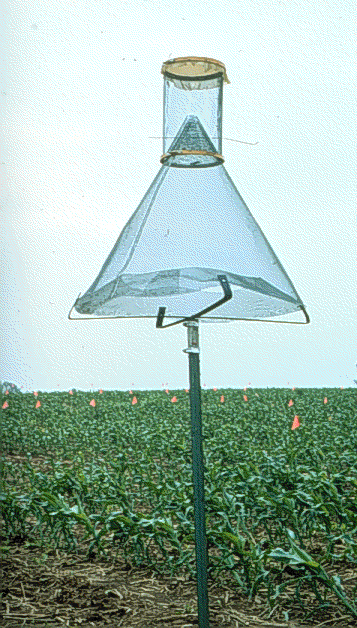
Pheromone Trap
Things you absolutely have to know about moths
- Moths have four wings, the first pair are the fore wings, the second pair are the hind wings or underwings.
- Moths are covered with scales giving them color or patterns. These scales are easily rubbed off, after which all moths look about the same.
- Identifying moths from their color patterns is an art. There is NO substitute for experience. Look for large numbers of the same moth. Send moths in for identification to verify your decisions.
Things you should know about trapping
- Always label the trap with the name of the species you are trapping and the date the bait was changed. Once the bait is out of the package you can not tell what it is. Humans can not smell insect pheromones.
- Baits usually last only 4 to 5 weeks so change monthly.
- Do not leave spent baits or bait wrappers near the traps. Even the most minute amount of pheromone may compete with your bait.
- Wear rubber gloves or wash your hands between handling baits. If your are not careful, you can cross contaminate your baits. Moths can detect these pheromones in nanogram quantities (1 nanogram = 0.000000001 gm). Minute traces of other chemicals can render some baits completely ineffective.
- Always remove all captured moths during each visit. Discard these individuals away from the field. Large numbers of moths can be dumped into a trash bag and then disposed of outside the field.
Pest Identification
The following information is specific to each insect. The dates for setting traps are based on a two week lead time for the average first capture at the University of Kentucky Research and Education Center in Princeton, KY. Setting traps at this time should ensure that your traps are in place before the first flight.
*Please note: The page (pg) and plate (PL) numbers refer to the locations of the written and photographic descriptions of these moths in: Covell's Eastern Moths.
Black Cutworm pg 90 PL 19(9)
When to set trap: March 1st
Moth ID: reddish-brown with front wing that is brown to black in the center two thirds and clay colored near the tip. There is a distinct black "dagger-like" dash near the front margin of each fore wing.
Other uses: Trap data indicates when to begin a degree day model for predicting larval (damaging) activity. Target: 300 DD. Base: 51°F.
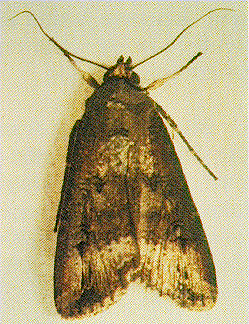
Black Cutworm Moth
True Armyworm pg 105 PL 22(18)
When to set trap: March 1st
Moth ID: uniform pale-brown or brownish- grey, with a 1-1/2 inch wing span. A single, small but prominent white dot in the center of each fore wing.
European Corn Borer pg 397 PL 57(20)
When to set trap: May 1st
Moth ID: yellowish brown, with irregular darker olive-brown bands running as wavy lines across the wings. These moths are very pointed, reminding one of a delta winged jet. The moth has a wingspan of about 1 inch.
Other uses: Trap catches are used with a degree day model to predict various stages of ECB life cycle (hence damage). This will help to determine when to scout for the larval stage.
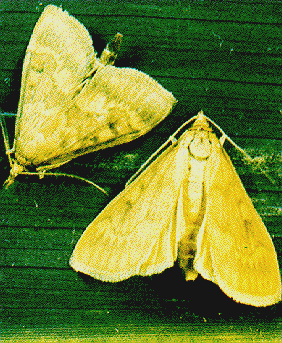
European Corn Borer Moth
Corn Earworm pg 141 PL 29(14)
When to set trap: March 15th
Moth ID: a wing expanse of about 1-1/2 inches, a light grayish brown, marked with dark-grey irregular lines with a dark area near the tip of the wing. The irregular lines often shade into an olive-green. Hind wings are white with some dark spots or irregular markings.
Other Uses: (experimentally) may be used as a threshold for scheduling insecticides for sweet corn.

Corn Earworm Moth
Fall Armyworm pg 134 PL 28(9)
When to set trap: June 1st
Moth ID: about 1-1/2 inches across the wings, the hind wings grayish white, the front pair dark gray, mottled with lighter and darker splotches and having a noticeable whitish spot near the extreme wing tip. They hold their wings over them tent-like while at rest.
Possible Confusion: Beet armyworm. BAW is smaller than FAW.
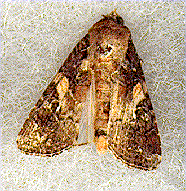
Fall Armyworm Moth
Tobacco Budworm pg 141 PL 29(12)
When to set trap: March 15
Moth ID: about 1 1/2" wing spread, front wings light-green and crossed by four oblique light bands the inner three of which are edged in black.
Possible Confusion: Corn earworms. Earworms are usually larger.
Beet Armyworm pg 133 PL 28(15)
When to set trap: June 1st
Moth ID: Forewing dark and mottled with lighter markings, Hind wing thinly covered with whitish scales.
Possible Confusion: Fall armyworm. (BAW is smaller than FAW)
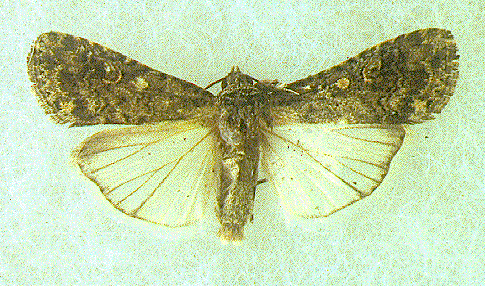
Beet Armyworm Moth
Other Useful Resources
- Bessin, R. Beet Armyworm In Kentucky. ENTfact-308.
- Bessin, R. Fall Armyworm In Corn. ENTfact-110.
- Bessin, R. Predicting European Corn Borer Development. ENTfact-106.
- Covell, C. V. Eastern Moths. Houghton Mifflin Co. Boston. 1984.
- Johnson, D. and S. McNeill. Plans and Parts List for the "Texas" Style Cone trap for Monitoring Certain Insect Pests. ENTfact-010.
- Johnson, D. Vendors of Microbial and Botanical Insecticides and Insect Monitoring Devices. ENT-54
Revised: 1/94
CAUTION! Pesticide recommendations in this publication are registered for use in Kentucky, USA ONLY! The use of some products may not be legal in your state or country. Please check with your local county agent or regulatory official before using any pesticide mentioned in this publication.
Of course, ALWAYS READ AND FOLLOW LABEL DIRECTIONS FOR SAFE USE OF ANY PESTICIDE!
Photos courtesy Ric Bessin, University of Kentucky Entomology
